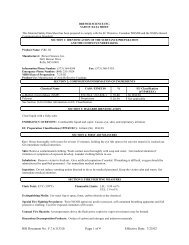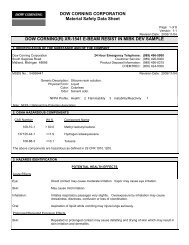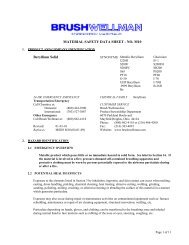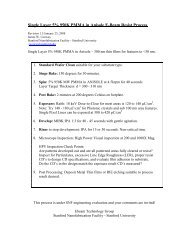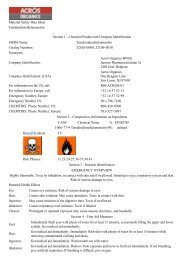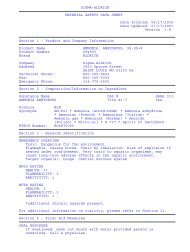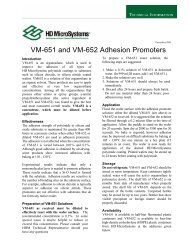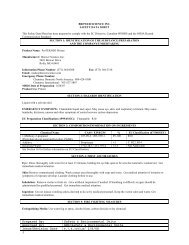(dimethylamino) hafnium - Stanford Nanofabrication Facility
(dimethylamino) hafnium - Stanford Nanofabrication Facility
(dimethylamino) hafnium - Stanford Nanofabrication Facility
Create successful ePaper yourself
Turn your PDF publications into a flip-book with our unique Google optimized e-Paper software.
Product: Tetrakis(<strong>dimethylamino</strong>)<strong>hafnium</strong> P-6280-B Date: February 2005<br />
8. Exposure Controls/Personal Protection<br />
VENTILATION/ENGINEERING CONTROLS:<br />
LOCAL EXHAUST–Inadequate; see SPECIAL.<br />
MECHANICAL (general)–Inadequate; see SPECIAL.<br />
SPECIAL–Use only in a closed system. This material is air- and moisture-sensitive. It should be<br />
maintained under a dry, inert atmosphere and used in an enclosed device such as a glove box.<br />
OTHER–See SPECIAL.<br />
RESPIRATORY PROTECTION: Respirators must be acceptable to MSHA and NIOSH. Respiratory<br />
protection must conform to OSHA rules as specified in 29 CFR 1910.134.<br />
SKIN PROTECTION: Wear work gloves when handling containers; rubber where contact with product<br />
may occur.<br />
EYE PROTECTION: Wear safety glasses when handling containers. Select eye protection in<br />
accordance with OSHA 29 CFR 1910.133.<br />
OTHER PROTECTIVE EQUIPMENT: Protective clothing where needed. Select in accordance with<br />
OSHA 29 CFR 1910.132 and 1910.133.<br />
9. Physical and Chemical Properties<br />
MOLECULAR WEIGHT: 354.80 g/mol<br />
SOLUBILITY IN WATER: Reacts with water.<br />
BOILING POINT at 0.1 mm Hg (0.00193 psi): 135°F (57°C)<br />
MELTING POINT: 84°F (29°C)<br />
APPEARANCE, ODOR, AND STATE: Pale yellow solid with low melting point, slight amine odor.<br />
10. Stability and Reactivity<br />
STABILITY: Unstable Stable<br />
INCOMPATIBILITY (materials to avoid): Water, moisture, air, strong oxidizers, halogens, acids, bases,<br />
protic solvents<br />
HAZARDOUS DECOMPOSITION PRODUCTS: Thermal decomposition or burning may produce CO,<br />
CO2, dimethylamine, <strong>hafnium</strong> oxide, organic fumes, and zirconium oxide.<br />
HAZARDOUS POLYMERIZATION: May Occur Will Not Occur<br />
CONDITIONS TO AVOID: Contact with water or moisture<br />
See section 3.<br />
11. Toxicological Information<br />
12. Ecological Information<br />
Tetrakis(<strong>dimethylamino</strong>)<strong>hafnium</strong> does not contain any Class I or Class II ozone-depleting chemicals.<br />
Tetrakis(<strong>dimethylamino</strong>)<strong>hafnium</strong> is not listed as a marine pollutant by DOT.<br />
Page 4 of 8



